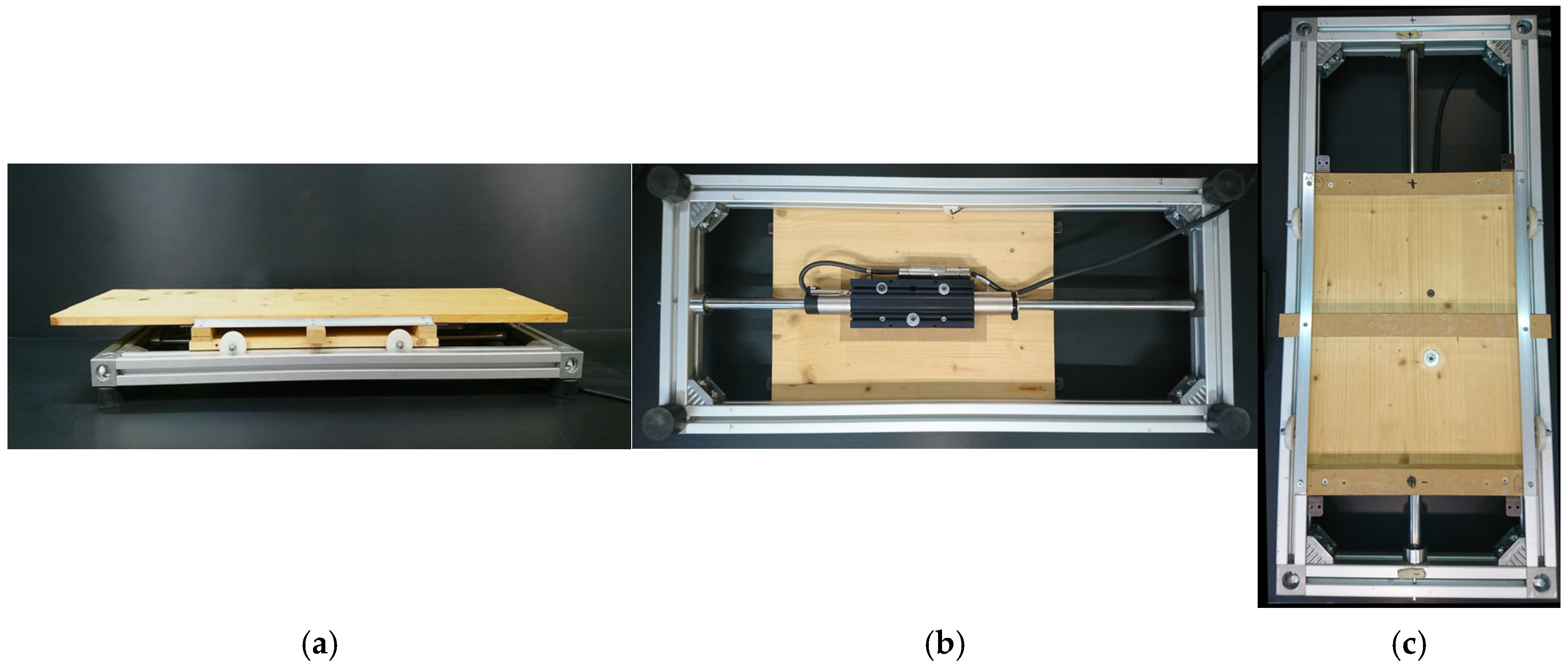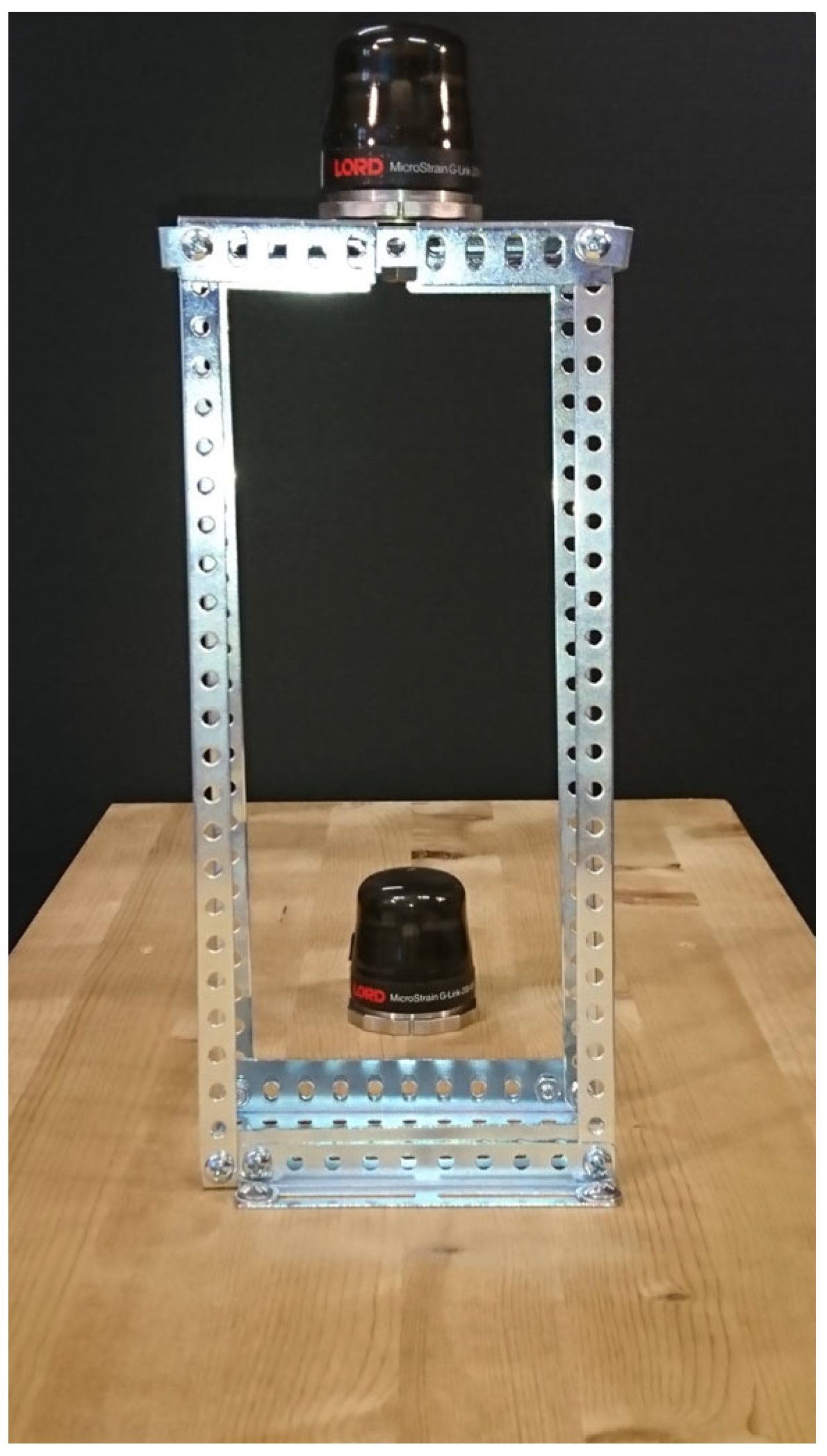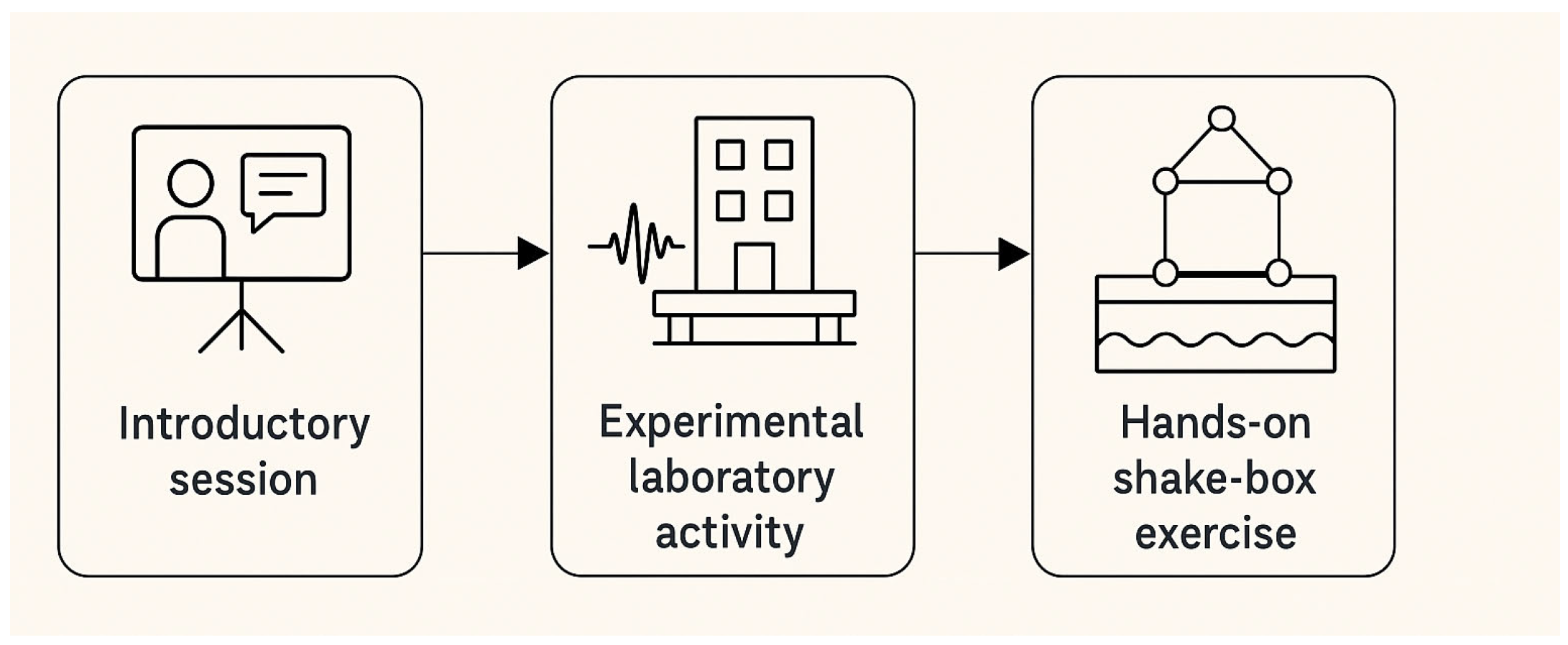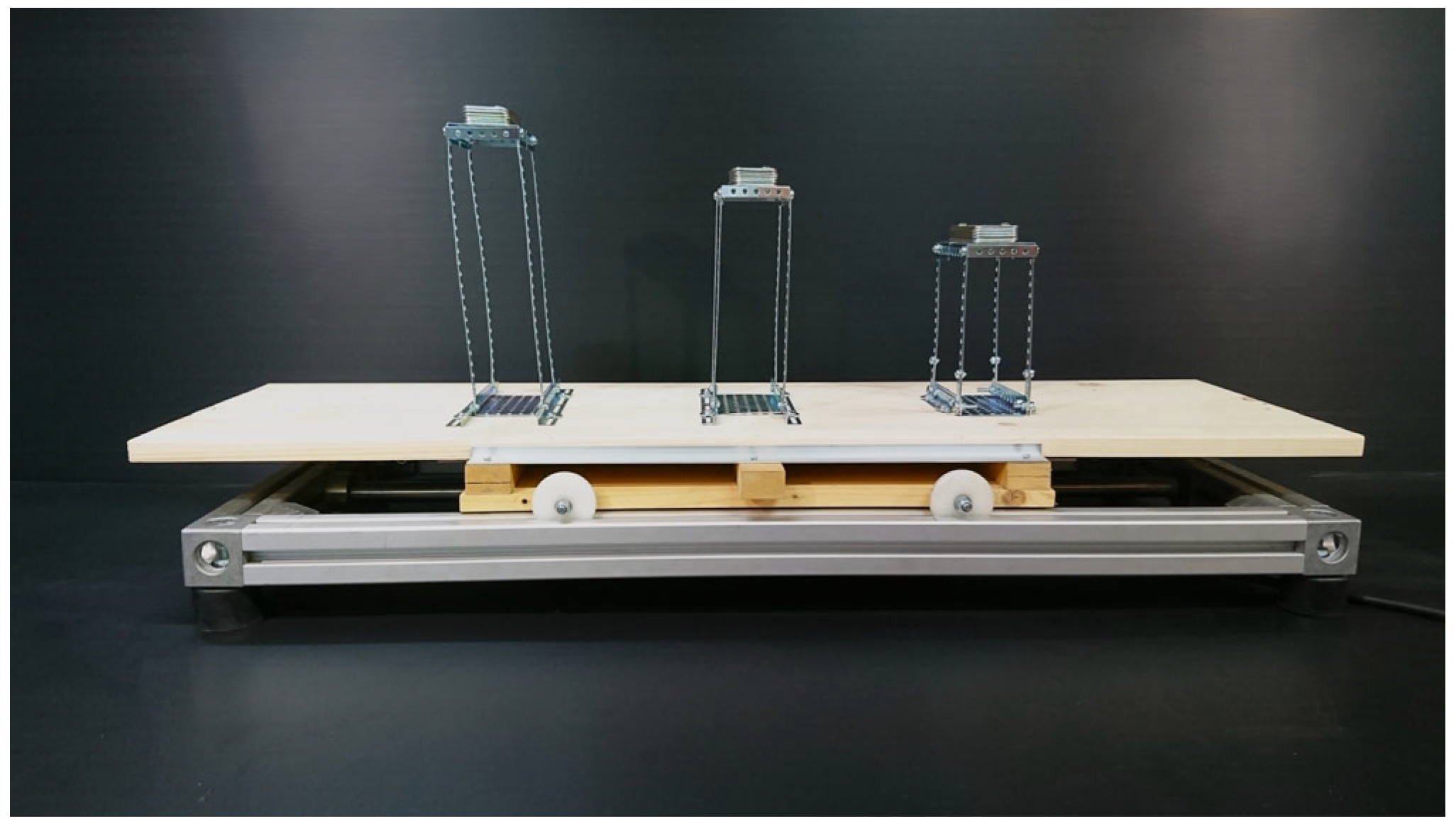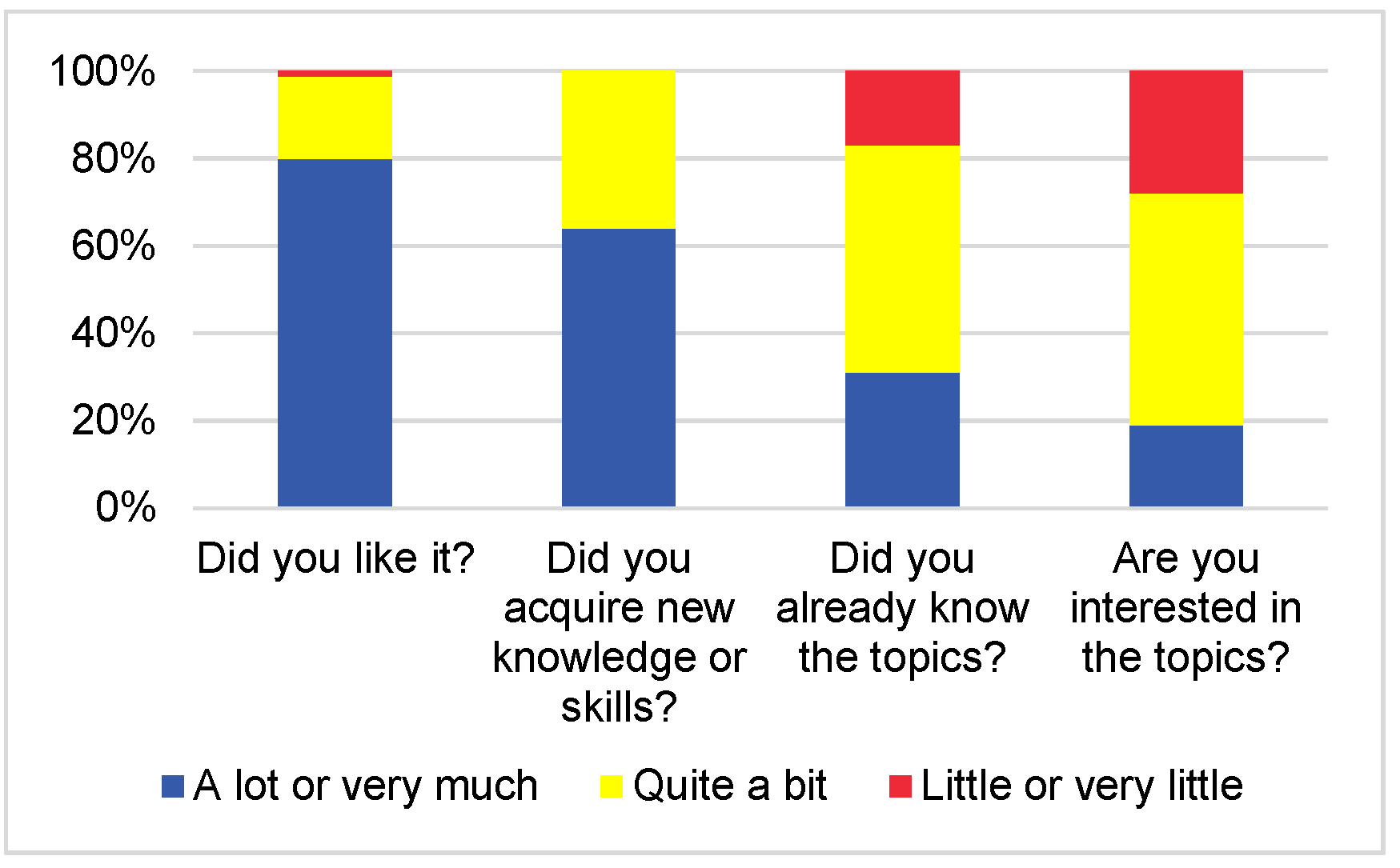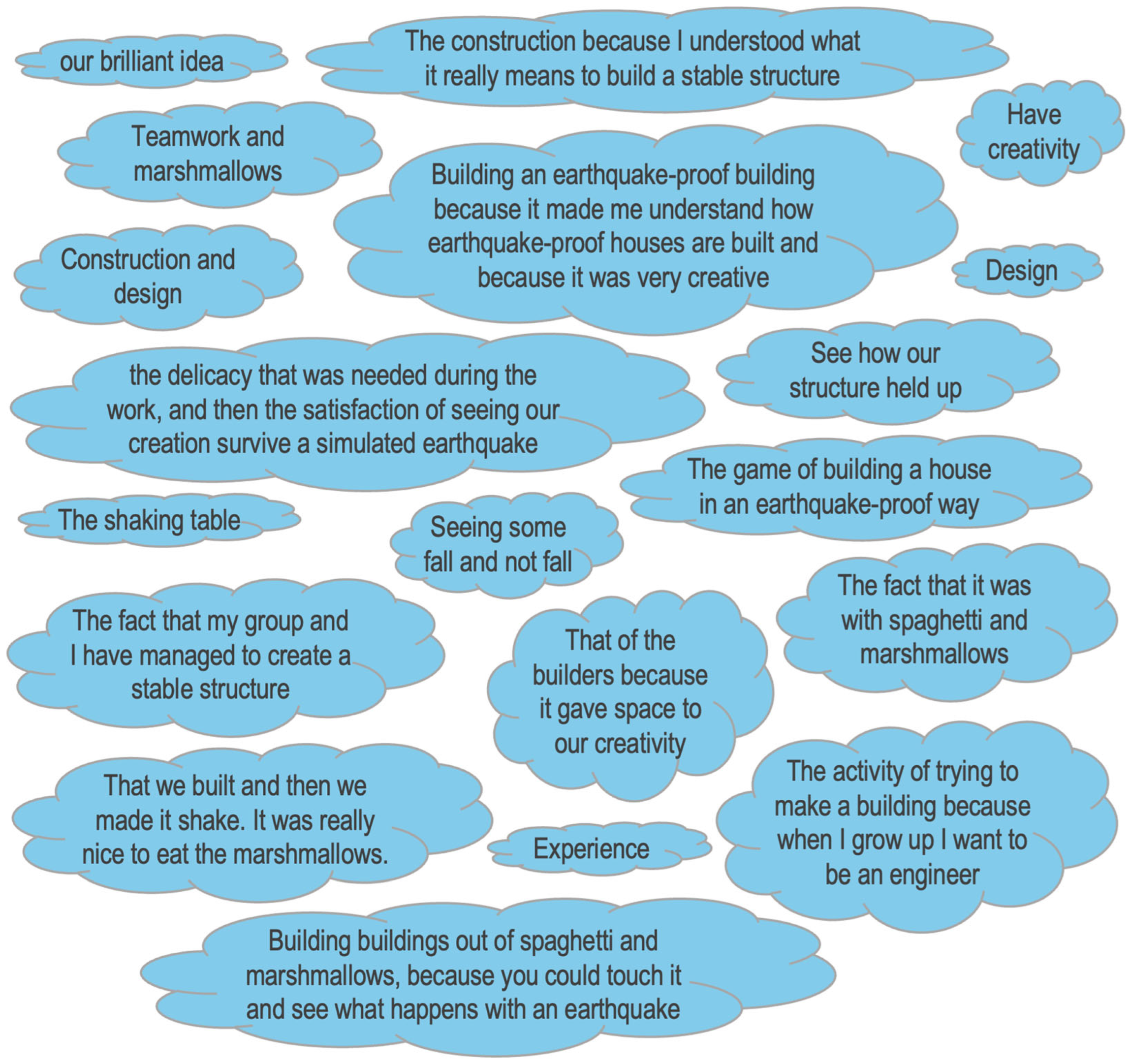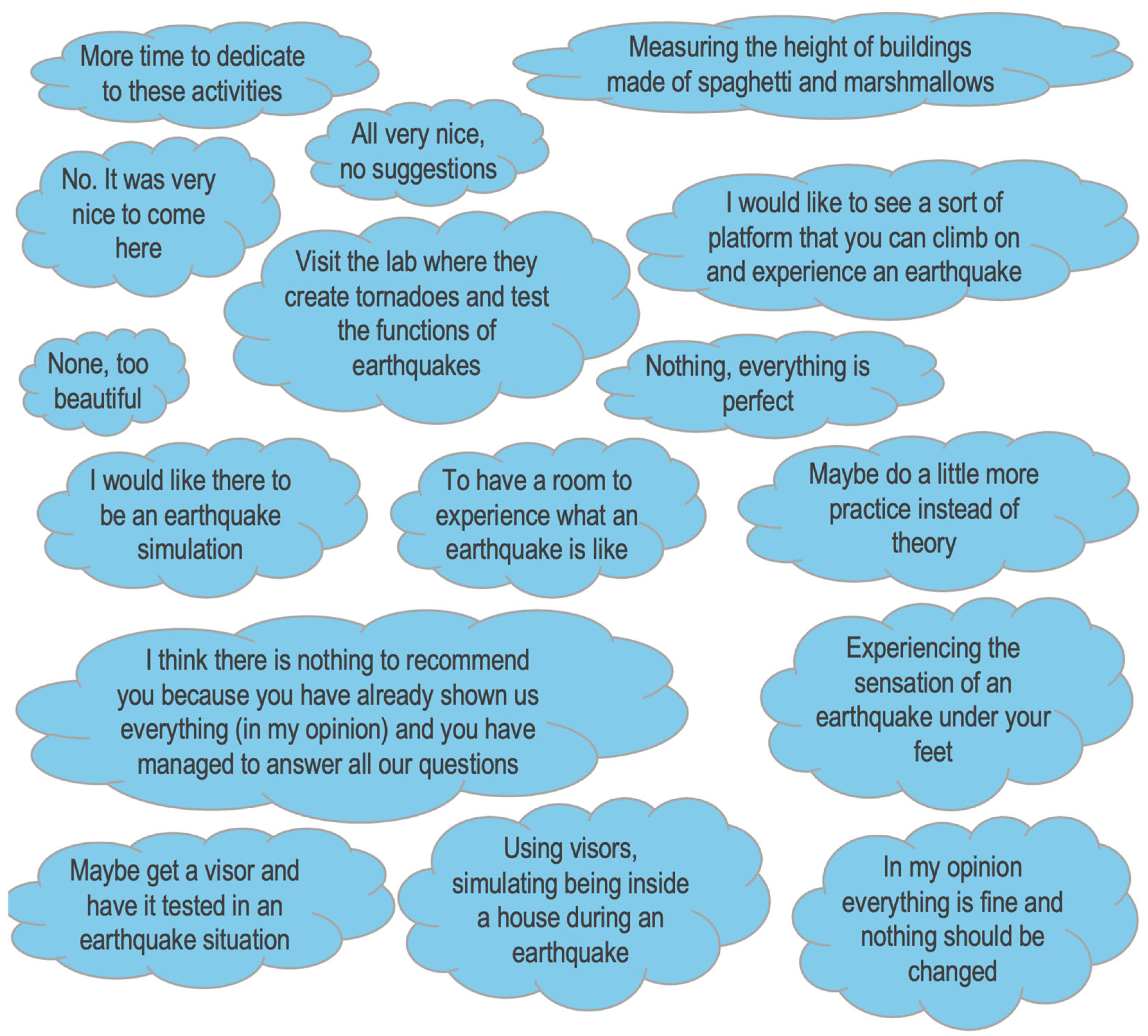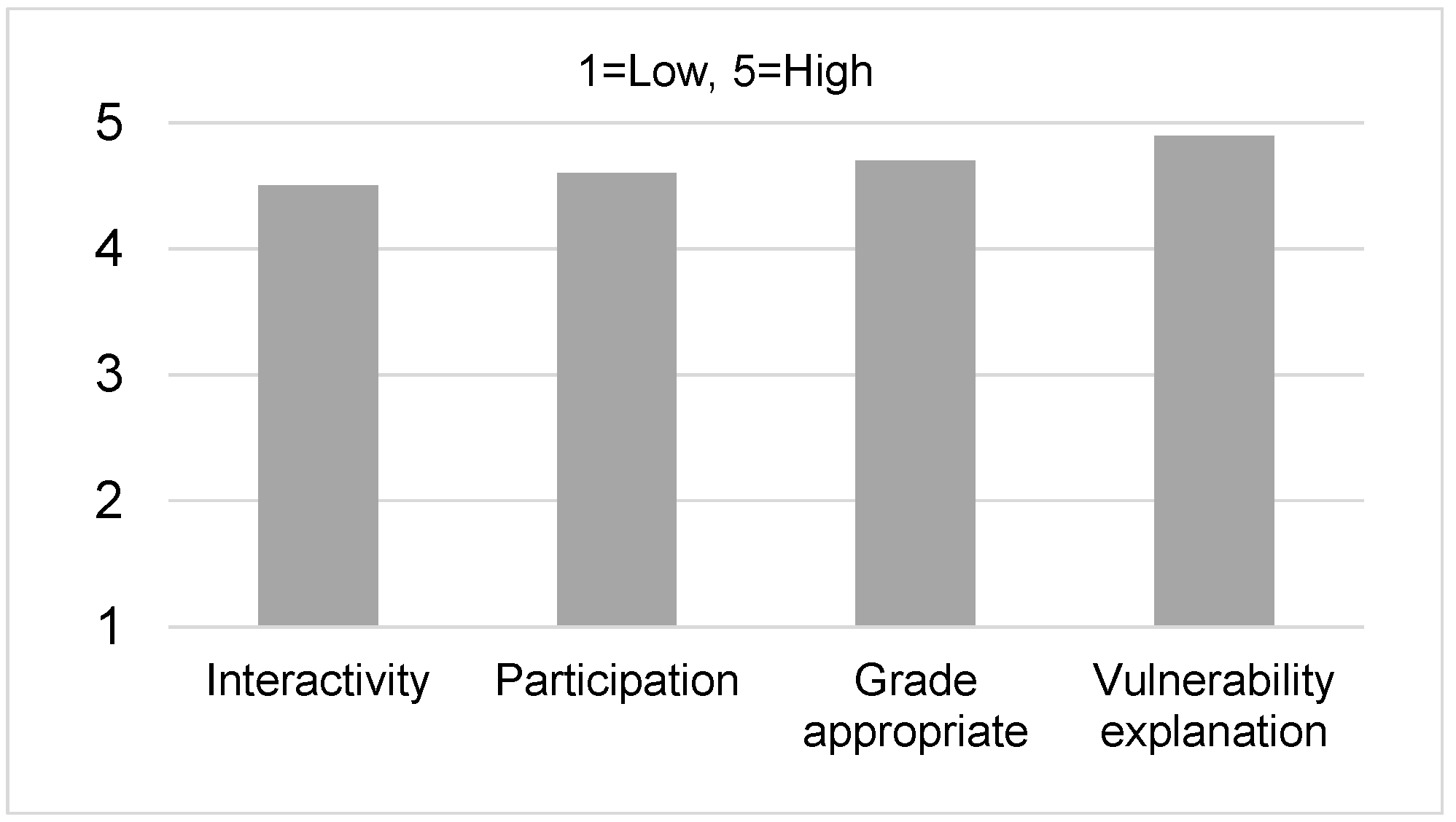1. Introduction
Earthquakes are among the most unpredictable and destructive natural disasters, causing substantial loss of life, property damage, and economic disruption worldwide. The sudden release of energy during an earthquake leads to ground shaking, which can severely affect buildings and infrastructure, especially in seismically active regions. Due to the catastrophic potential of earthquakes, educating individuals, particularly students, about seismic phenomena, structural responses, and disaster preparedness is essential. Integrating earthquake education into school curricula not only enhances students’ understanding of geophysical processes but also fosters a culture of safety and resilience from an early age [
1,
2].
In this context, seismic risk education plays a key role in disaster risk reduction (DRR) and aligns with global frameworks such as the Sendai Framework for Disaster Risk Reduction 2015–2030. This framework emphasises proactive measures to reduce the impact of natural hazards. Research has demonstrated that engaging young learners in structured educational programs not only raises awareness of seismic risks but also empowers them to take preventive actions, thus contributing to building resilience at the community level [
3].
Despite progress in this field, there remains a gap between theoretical knowledge and practical application in educational initiatives addressing seismic hazards and seismic risk [
4]. To bridge this gap, it is crucial to adopt innovative approaches that combine scientific rigor with interactive, hands-on and social learning. These experiential and constructivists learning theories suggest the integration of concrete experience, reflective observation, abstract conceptualisation, and active experimentation, encouraging students to directly engage with the concepts being taught [
5,
6].
In seismic risk education, hands-on activities, such as using shaking tables to test model structures, provide a concrete way to explore complex concepts like resonance, structural vulnerability, and earthquake-resistant design. These activities not only enhance cognitive understanding but also foster emotional engagement, which is essential for internalising risk awareness and contributing to a broader culture of preparedness and resilience. This aligns with findings that emphasise the role of education in fostering community-level transformations toward safer practices and infrastructures [
7,
8].
In this paper, we present the Shake it! learning module, which exemplifies this approach by combining the theoretical principles of structural engineering and seismic science with experiential learning. Implemented in diverse settings, ranging from open-day events at research institutions to classroom programs, it has reached hundreds of students and educators. Feedback from participants highlights the success of the module in conveying important messages about earthquake preparedness in a way that is both accessible and lasting.
2. Educational Applications of Shaking Tables: A Review of Practice
Shaking tables are advanced tools used in research and engineering to replicate earthquake motions and study structural responses. This enables engineers to assess performance, identify failure mechanisms, and develop more effective earthquake-resistant designs [
9].
Shaking tables are also effective in earthquake awareness campaigns, providing a tangible and lasting understanding of seismic events by letting participants physically feel ground motion. One prominent example is
Seismic City [
10] and
Seismic Room [
11], included in the
Terremoti d’Italia exhibition organised by the Italian Civil Protection Department. Seismic City is a shaking table that replicates an urban environment with buildings and bridges at a 1:25 scale to show how different structures respond to earthquakes. Similarly, the Seismic Room is a shaking table measuring 4.40 × 0.200 m, hosting up to 10–12 adults. It can reproduce different earthquake motions. Since 2007, date of the first event, the exhibition was mounted 29 times in different Italian cities. Another example, still in Italy, is the
SEISMULATOR, a mobile shaking table measuring 5 × 2 m, created by EUCENTRE [
12] which can be transported by a truck. It enables participants to experience different seismic shaking. Similar tools exist in many other countries around the world. See for instance [
13] for the Philippines or the
SISMOBUS in the French Antilles [
14], and in Algeria [
15].
In educational settings, the implementation of shaking tables varies widely, from simple, cost-effective models to more sophisticated systems. The primary objective is to provide experiential learning opportunities that align with educational goals and resource availability. Mellors and de Groot [
16] discussed how demonstrations are highly relevant at the K–12 and university levels and the benefit by seeing graphic examples of phenomena such as resonance. The term “shake table” is used in a generic and all-encompassing fashion, with the simplest version as a wooden board on rollers that can be shaken by hand.
Early initiatives in US addressing undergraduate students started with the University Consortium on Instructional Shake Tables (UCIST) developed in 1999 [
17,
18] to foster collaborative teaching and learning at the university level.
Quanser Shake Table II (STII) served as the standard shake table for the Consortium. UCIST also included a K-12 outreach activities in earthquake engineering, where K’Nex™ and Lego™ buildings were used. In the following years (2007–2014), education and outreach activities were implemented as part of the Network for Earthquake Engineering Simulation (NEES). Existing materials and various digital libraries with K-12 lesson plans were gathered, refined to meet new learning goals [
19] and made available on NEESacademy [
20], an educational portal on the NEES website.
NEESacademy included Grades 4–5, Grades 6–8, Grades 9–12, and K-12 activities. Among Grade K-12, the module Shake Things Up! made use of shaking tables. The NEES research site at UC Santa Barbara designed a K-12 activity called “
Make Your Own Earthquake” (MYOE) [
21]. MYOE brings earthquake field equipment into the classroom, letting students jump to generate seismic waves, view their personal earthquake trace in real time, and take home a printed copy. The NEES research site at UC Berkeley [
22] developed hands-on lessons using small educational shaking tables and K’Nex™ materials to build and test models [
23], focusing on 4th grade students. The module was composed by two 90 min classroom visits and an optional field trip to the earthquake engineering laboratory. Some of the material used at Berkely is presented in the work by Mendoza [
24], including interesting experiments simulating brittle failures with chalk elements, later wrapped with packing tape to become ductile. The K-12 education program is still available at PEER, with the NEES@Berkeley Laboratory running an outreach program to engage elementary and high school students. The full lesson set, including a curriculum and a materials list for building your own shake tables, is available [
22,
25]. The NEES educational activities and the lessons learnt over 5 years are summarised in the work by Brophy and Anagnos [
26].
In 2014, the Earthquake Engineering Research Institute (EERI) launched the School Earthquake Safety Initiative (SESI), utilising the NEES@Berkeley 4th grade lessons [
27,
28]. SESI also includes a high school curriculum focused on the design, construction, analysis, and testing of balsa wood structures. This curriculum, available on the EERI website, closely mirrors the one offered at PEER. Additionally, EERI organises the Seismic Design Competition for undergraduate students, where they design and construct scaled balsa wood models tested on a shaking table and evaluated for performance [
29].
In Italy, following the awareness raised by the 2009 L’Aquila earthquake, the Interregional Network for Seismic Education was established in 2015, formalising a network of secondary schools (grades 6th–8th and 9th–13th) through an official agreement (RESISM). Starting with eight schools in two regions, the network expanded by 2021 to include 26 more schools across ten regions [
30]. This ongoing initiative uses shaking tables with simple models made of plastic or wood, allowing students to explore key concepts such as resonance and inertial forces.
Another educational initiative,
Shake It Up! Engineering for Seismic Waves [
31], is a STEM-aligned (Science, Technology, Engineering, and Mathematics) activity primarily aimed at 8th grade students. In this activity, students design and build their own shake tables to test model buildings made from toothpicks and mini marshmallows. After ensuring their models’ stability, students subject them to a one-minute simulated earthquake challenge. The primary shaking table mechanism uses a variable-speed drill to generate motion, with a simpler version also available [
31]. The activity lasts approximately 1 h and 45 min, providing an engaging, hands-on approach to understanding seismic engineering. Similar initiatives were undertaken at the Joint Research Centre to introduce school students to the fundamental concepts of earthquake engineering [
32]
In addition to the initiatives mentioned, another educational unit for 3rd–5th grade students is part of the Engineering Adventures curriculum developed by the Museum of Science, Boston, for EiE-YES (Engineering is Easy—Youth Engineering Solutions). This unit,
Shake Things Up: Engineering Earthquake-Resistant Buildings, introduces children to earthquake engineering through the Engineering Design Process. Students work on an earthquake engineering design challenge, including designing model earthquake-resistant buildings, testing them on simple shaking tables, and creating their own building codes [
33]. The unit consists of nine activities, each taking about 45 min to complete. The educator guide provides instructions for constructing shake tables with common office supplies like tape and rubber bands, with additional tips available in [
34].
In response to the challenges posed by the global pandemic,
Virtual Earthquake [
35] was developed as a remote learning adaptation of shaking table-based activities for K-12 students. In this program, students construct their own shaking table at home, build and retrofit structural models using Mola [
36], and collect and analyse data with a low-cost accelerometer. These activities are complemented by lectures on earthquake hazards, seismic design, and instrumentation.
Key challenges and lessons learned on educational activities using shaking tables include the importance of distinguishing between different instructional approaches, such as direct versus discovery-based teaching, domain-general versus domain-specific knowledge, and physical versus virtual materials, as emphasised by Klahr [
37]. His study found that all approaches were equally effective in improving learners’ knowledge. Mendoza et al. [
23] highlighted the need to maintain student engagement, advising against complex slides or long lectures and advocating for simplicity and age-appropriate content. Brophy and Anagnos [
26] pointed out challenges in monitoring progress toward learning goals and the need for identifying suitable personnel to implement and evaluate activities. Finally, Kjolsking [
38] stressed the importance of breaking down concepts for high school students (9th–12th grade) and presenting them through a combination of lectures, videos, peer instruction, and hands-on projects to improve comprehension.
3. Materials and Methods
Shake It! is an interactive learning module designed to engage students in three core topics: construction materials, structural components, and seismic response. By combining interactive presentations, visual aids, and hands-on experiments, the module applies experiential learning principles, emphasising the value of learning by doing and constructivist approaches [
5,
6].
A central element of the module is the design and testing of model structures on shaking tables. This practical activity enables students to observe firsthand how seismic forces affect buildings, deepening their understanding of key earthquake engineering concepts such as resonance, structural integrity, and failure mechanisms. This approach is supported by research showing that hands-on activities in STEM education not only enhance problem-solving skills but also strengthen students’ grasp of complex concepts [
38,
39].
The primary learning goal is to help students understand the main factors influencing building vulnerability and the basic principles of earthquake-resistant design. The core message is that structural vulnerability can be significantly reduced through appropriate engineering solutions.
The
Shake It! module includes three main activities, which are also presented in
Figure 1 and described in detail below:
Introductory and preparatory session: provides foundational knowledge.
Experimental laboratory: uses a portable shake table to test model structures.
Hands-on activity: employs a simplified cardboard “shake box”, to simulate seismic effects in a more accessible format.
This structured progression fosters active engagement and critical thinking, making complex scientific principles easier to understand and retain.
Designed for students aged 12 to 14, the module assumes only a basic understanding of wave-related physics. However, it can be adapted for high school students by increasing the level of complexity, particularly in the experimental phase using the portable shaking table.
The module’s duration depends on the context: from 40 min to 1 h in structured programs with multiple modules, and up to 1 h and 30 min in standalone format. The construction of the cardboard shake box can extend over several class periods, offering a cross-curricular opportunity that integrates science, technology, and design.
3.1. Introductory and Preparatory Session
An introductory PowerPoint presentation is used to spark discussion and introduce fundamental concepts, helping students become familiar with earthquakes, structural elements, and seismic building behaviour. Depending on the time available, the presentation may also include interactive quizzes in which students match construction materials and structural schemes with real-world examples. The full presentation lasts approximately 10–15 min and is structured as follows:
Earthquake ground motion. This section explains that seismic ground motion occurs in all directions and varies continuously in intensity and direction, generating accelerations. A video of the 2016 Central Italy earthquake is shown to illustrate this phenomenon. Choosing a locally relevant or widely recognised event can help enhance student engagement.
Vibration modes. Students are introduced to the concept that each building has its own natural periods of vibration. Videos showing the first, second, and third vibration modes of numerical models are presented, along with a discussion on the potential for resonance.
Construction materials and structural schemes. This part introduces students to key construction materials (reinforced concrete, steel, masonry, and wood) and typical structural schemes (frames, walls, and bracings) used in building design.
Shaking tables. The section describes the role of shaking tables in earthquake engineering research, supported by videos demonstrating their operation and laboratory tests that reveal structural behaviour under seismic loads.
Models for the shake-box. Students learn how to build simple physical models, such as spaghetti and marshmallow structures, to explore structural concepts and seismic effects. This serves as preparation for the upcoming hands-on shake-box activity.
3.2. Portable Shaking Table Laboratory
This section of the learning module provides an in-depth exploration of seismic vulnerability, with a particular focus on the concept of resonance. The dynamic characteristics of buildings are critical for predicting their seismic behaviour and, ultimately, their vulnerability. One of the most significant of these characteristics is the fundamental period of a building [
40]. If the predominant frequency of ground motion during an earthquake aligns with a building’s fundamental period, resonance can occur, amplifying oscillations and increasing the likelihood of structural failure [
41]. This concept is simplified for students by explaining that, if an earthquake contains frequencies matching the fundamental frequency of a building, the structure will experience the strongest oscillations.
The laboratory activity includes two experiments designed to illustrate how buildings respond to seismic forces and how resonance can significantly affect their behaviour. The experiments are conducted using a low-cost shaking table specifically designed and built for this laboratory, as described in
Appendix A.
While the educational module using an experimental shake table offers a powerful tool for teaching middle school students about resonance and building vibration, its implementation may face several barriers. First, the cost of materials and equipment can be significant. The shake table itself costs approximately EUR 6000, which may be a substantial investment for many schools or educational institutions. Second, the operation of the shake table requires specialised personnel with technical skills to safely and effectively run experiments. Without such expertise, the educational value of the module may be diminished, and safety risks could arise. Third, time constraints within standard school curricula may limit opportunities to integrate a full laboratory session, particularly if setup, experimentation, and interpretation require multiple hours. Finally, teachers may require additional training to confidently guide students through the concepts of structural dynamics and manage hands-on activities involving the shake table. Without targeted professional development, the module may be underused or misapplied. Addressing these barriers is essential to ensure the broader adoption and long-term sustainability of the program in educational settings. Some recommendations are discussed in the conclusions.
3.2.1. Experiment 1: Single Building Test
This experiment investigates the dynamic response of a single building model subjected to seismic motion. The mock-up consists of a one-story, one-bay frame (60 × 110 × 255 mm) with four vertical elements oriented in the same direction, connected by top and bottom plates. The base plate is securely bolted to the removable wooden platform of the shaking table (
Appendix A), ensuring stability during testing.
The model (
Figure 2) behaves as a single-degree-of-freedom system, similar to an inverted pendulum, with two distinct natural periods along the two axes. Along the direction of motion of the shaking table, the fundamental period is T
1 = 0.17 s (f
1 = 5.66 Hz).
To measure the building’s seismic response, two Wi-Fi accelerometers (see
Appendix A) are installed:
One at the top of the building, acting both as a sensor and an added mass.
One at the base, mounted directly on the wooden platform.
Three different tests are conducted, with accelerometer data from the two sensors displayed on a large screen for students to observe and analyse (
Figure 3):
Free vibration test. The structure is manually displaced and then released, allowing it to oscillate freely. This helps students understand the natural period of vibration and damping effects.
Forced ground motion. A scaled real recording of the 2016 Central Italy earthquake (Mw = 6.5, 30 October 2016) is used as input. Students observe the amplification of motion at the top of the building mock-up compared to the input ground motion, leading to discussions about how different floors of a building experience shake differently. This test is particularly impactful for students who have never experienced an earthquake, often prompting lively discussion.
Resonance test with synthetic sinusoidal input. The model is subjected to four consecutive sinusoidal inputs with increasing frequency (f1 = 2 Hz, f2 = 4 Hz, f3 = 5.66 Hz, f4 = 10 Hz). Students observe how a building amplifies or attenuates the ground motion and how resonance occurs when the input frequency matches the building’s fundamental frequency. When this happens, the model exhibits pronounced oscillations, visually illustrating how resonance increases vulnerability. This test also shows that only certain frequency components of ground motion significantly influence building response.
3.2.2. Experiment 2: Multiple Building Test
This experiment builds on the concept of resonance by introducing three building mock-ups with identical plan dimensions (60 × 110 mm) but varying heights: H1 = 155 mm, H2 = 205 mm, and H3 = 255 mm. Each model consists of four vertical elements with the stiff part oriented in the same direction, a top and bottom plate, and an added mass (m = 0.12 kg). To prevent failure during testing, the shortest model is reinforced with additional vertical elements at the base.
As in Experiment 1, the base plates of each model are bolted to the removable wooden platform to ensure uniform testing conditions. The models behave as single-degree-of-freedom structures (inverted pendulums), each with a different vibration period. Along the direction of motion of the shaking table, the periods and frequencies are: T
1 = 0.25 s (f
1 = 4.0 Hz), T
2 = 0.16 s (f
2 = 6.0 Hz), and T
3 = 0.10 s (f
3 = 10.0 Hz). The models on the shaking table are shown in
Figure 4.
Unlike experiment 1, no accelerometers are used. Instead, students analyse visual resonance effects as the models are subjected to a sinusoidal ground motion ranging from 2 Hz to 10 Hz (f1 = 2 Hz, f2 = 4 Hz, f3 = 6 Hz and f4 = 10 Hz), each lasting 10 s to allow for the observation of the shaking effects.
Each model resonates at different frequencies (
Figure 5), corresponding to its fundamental frequency. The tallest, most flexible building mock-up resonates first, followed by the medium-height model, and finally the shortest, stiffest structure. When one building resonates, the other two remain relatively still, visually reinforcing the concept of frequency-dependent amplification.
This experiment helps students gain a deeper understanding of how height, stiffness, and mass influence seismic response, and why buildings of different designs experience varying levels of damage during the same earthquake.
The duration of this session within the learning module ranges from 10 to 20 min.
3.3. Shake Box Hands-On Activity
The
Shake Box activity offers a hands-on, accessible way to understand seismic resistance. Students construct beam-column structures using spaghetti and marshmallows, representing the structural skeleton of buildings. These structures are then tested on a cardboard-based shaking platform (
Figure 6a).
The
Shake Box is a cardboard model of a portable shaking table (see
Appendix B for assembly instructions). It is powered by an eccentric motor (
Figure 6b), which generates horizontal oscillations, and features elastic bands to attach the platform to the base. Sample holders secure the structures during testing, allowing students to analyse the effects of seismic motion.
The activity consists of progressive structural tests using the Shake Box:
Bracing Test. A structure with bracing elements is tested, demonstrating stability under shaking forces.
Progressive Weakening. Bracing elements are gradually removed, reducing structural resistance. Students observe how seismic resistance decreases until the structure ultimately collapses.
This activity reinforces fundamental engineering concepts, including:
How beam-column structures behave under seismic forces.
The role of bracing in enhancing structural stability.
The relationship between stiffness, mass, and earthquake damage.
Although it may appear suited for younger students, this activity is best for those aged 12 and older, as it requires fine motor skills to assemble and manipulate the delicate spaghetti structures (
Figure 6c). The duration of this activity ranges from 20 min to 1 h, depending on the depth of the experiments and the educational setting.
By combining experimental analysis with creative problem-solving, this activity offers a tactile, engaging way for students to explore seismic engineering concepts.
4. Implementation and Testing
The
Shake it! learning module was initially developed as part of the third edition of the Geoscience Communication School, held in Castiglione del Lago, Italy, in 2018 [
42] where two of the authors participated as lecturers. This initiative aimed to enhance postgraduate students’ skills in communicating seismic risk management to school students. Since the school also included hands-on activities using easily accessible materials, the first version of
Shake it! featured only the
Shake Box activity, which was presented to postgraduate students. The activity was discussed in detail with them before they tested it with two classrooms of 5th grade schoolchildren. One notable challenge was the language barrier: the postgraduate students did not speak Italian, while the schoolchildren spoke only Italian. However, the highly visual and interactive nature of the
Shake Box and marshmallow-based structures allowed participants to engage seamlessly. This experience demonstrated how hands-on learning tools can transcend linguistic differences, making complex scientific concepts accessible regardless of language proficiency. However, the experience showed that 10-year-old schoolchildren needed assistance in handling the spaghetti and marshmallow structures.
Following the initial experiment, the module was expanded by integrating a portable shaking table. This addition provided a more advanced experimental tool to complement the Shake Box, allowing for a clearer demonstration of seismic resonance effects on building structures. The combination of both tools enhanced the educational impact, offering a hands-on activity alongside a more scientifically rigorous representation of earthquake dynamics.
From 2018 onward, the module was further refined, presented, and tested during INGV open-day events, such as ScienzAperta. It also became part of school-based educational initiatives within the DG-ECHO-funded project KnowRISK (Know your city, Reduce seISmic Risk). These events involved hundreds of students, providing opportunities to fine-tune the activities [
43].
At this stage of the implementation, the introduction of the learning module was systematised: students discussed ground motion and construction materials, supported by photographic evidence illustrating different structural behaviours during earthquakes.
In addition to open-day educational activities, the module was tested in schools, where students built their own Shake Boxes. This hands-on approach reinforced key interdisciplinary concepts. Alongside engineering and seismic risk, students explored principles of electricity by creating small handmade circuits, and physics as they worked to ensure the table’s motion was primarily horizontal.
For the assessment of the
Shake It! learning module, reference will be made to three editions of ScienzAperta held in 2023–2024, lasting 3 to 5 days, which involved more than 600 8th grade students from K-12 education. Shake It!” was part of an educational pathway that combined hands-on experimental activities with video gaming. The full program lasted approximately three hours and was specifically designed to engage young students with topics related to disaster risk mitigation and management. Alongside
Shake It!, three to four additional learning modules were included: experimental laboratory activities focused on measuring earthquake-related parameters and site effects, and video games addressing the occurrence of earthquakes within the context of plate tectonics and preparedness actions [
44].
4.1. Assessment of Shake It!
The learning modules engaging students at ScienzAperta in 2023, 2024, and 2025 were evaluated through questionnaires distributed to students and teachers. The aim was to assess the interest in the proposed modules, participation level, achievement of educational objectives, and gather comments and suggestions from participants. The questionnaires included both closed-ended questions, single or multiple choice, and open-ended questions. For answers requiring a quantitative evaluation, a 5-point Likert scale [
45] or a predefined scoring model was used.
Although the questionnaires varied across the three events, general trends can be extracted. A brief analysis of the survey results is provided below, with the total number of respondents reported in
Table 1.
4.1.1. Assessment of Shake It! By Students
In the 2023 ScienzAperta edition, for over 50% of the students it was the first time participating in practical awareness or risk education laboratories, and more than 85% express interest in returning for similar events. Of the four learning modules held, Shake it! was the most appreciated, with a score 12% higher than the average of the other modules, rising to 16% among students participating in similar events for the first time. The association between the Shake it! module and its educational objective was 80%, based on the correct answers to a closed-ended question asking the students to select the module they felt best met the objective “Understanding how buildings respond to earthquakes”.
Of the 92 students interviewed in the 2024 edition, 93% expressed interest in participating in similar events again. For 72% of the students, the most appreciated learning module was
Shake it!. The questionnaire focused primarily on the overall event. Eighty percent of students reported enjoying the event “a lot” or “very much,” and 64% felt they had gained “a lot” or “very much” new knowledge. Seventeen percent indicated that the topics were “little” or “very little” known to them beforehand. Twenty percent were “a lot” or “very much” interested in the topics covered, while about 25% reported being “little” or “very little” interested (
Figure 7).
Of the 117 students interviewed in the 2025 edition, the Shake it! module was the most popular, receiving a score 23% higher than the average of the other modules. Among the activities listed in the closed-ended question (e.g., “answering quizzes”, “video games”, etc.), “Building and modelling with your hands” received the most preferences, scoring 12% above the average of the other listed activities. When asked “How do you live with earthquakes?”, the three highest-scoring responses were as follows:
Knowing what to do in the event of an earthquake.
Finding ways to make buildings more resistant.
Increasing scientific and technological knowledge.
In response to the multiple-choice question “What influences the vulnerability of a building?”, 63% of students selected “The material the building is made of” while only 14% chose an obviously incorrect answer. For the question “What are bracings?”, 62% of responses included “elements that reinforce buildings.” Regarding the question “What were the objectives of Shake It!?”, 71% of the 110 respondents chose “to understand what makes buildings vulnerable” while only 7% selected the incorrect option “to understand that all buildings vibrate equally”.
The questionnaire concluded with a series of open-ended questions which provided valuable insights into the students’ perspectives. Some of the answers to the open-ended question “What did you learn from
Shake it!?” are shown in the bubble-chart in
Figure 8. The responses clearly indicate that the educational objective of the learning module has been achieved.
Some of the answers to the open question “What did you like most about
Shake it!?” are shown in the bubble-chart in
Figure 9. Common themes include construction, creativity, teamwork, building safety, and the use of materials such as spaghetti and marshmallows.
In response to the open-ended question “Which activity did you like the least?”, most students answered “Nothing”. Only a few mentioned issues such as “The activities were too close together without breaks” or “The explanation was too long”. Some students indicated that they liked certain parts less simply because the topics had already been covered at school; for example, “The constructions with spaghetti and marshmallows, because we had already done it in class” or “The theoretical part, only because the teacher had already explained some notions to us and, therefore, I already knew them”. A few responses also referred to emotionally charged content, such as “The deaths that have occurred over the years” or “The explanation of when the stadium collapsed”.
In the 2024 edition, students were also invited to share suggestions for improving
Shake it!, responding to the open-ended question: “Do you have any suggestions for us on what you would like to see, do, hear?”. Of those who responded, 63% did not provide suggestions most often because they felt the module was already adequate. Some of the responses are shown in the bubble-chart in
Figure 10, offering clear insight into potential activities that could be further developed.
Although each survey is analysed independently by year, the varying number of respondents (e.g., 15 students in 2023 versus 117 in 2025, see
Table 1) affects the statistical reliability within each dataset, especially for years with small samples. This also limits the extent to which findings can be generalised to a broader population. Additionally, changes in the questionnaire structure across years influence how results are interpreted and reduce the comparability of thematic trends over time.
4.1.2. Evaluation by Teachers
In the 2024 edition of ScienzAperta, 60% of teachers indicated that
Shake it! was their favourite learning module among those offered and 100% said they would participate in a similar event again. As with the student questionnaire, the questions for teachers focused primarily on the event as a whole. All teachers rated the event positively, with “a lot” or “very much” appreciation and 60% reported gaining “a lot” or “very much” of new knowledge. For 20% of the teachers, the topics covered were previously “little” or “very little” known, while 60% expressed “a lot” or “very much” interest in the subjects presented (
Figure 11).
In the 2025 edition, teachers were asked to evaluate in greater detail the three learning modules presented during the event. The evaluation of the
Shake it! module is shown in
Figure 12. Based on a 1-to-5 rating scale, the results clearly indicate that
Shake it! was perceived as highly interactive and participatory, well-suited to the students’ school level and effective in explaining the concept of seismic vulnerability in buildings. The scores assigned to the four components of
Shake it! were slightly above average by approximately 3 to 4%, compared to the scores for the same components in the other two learning modules.
In response to the open-ended question “What did you like most about the Shake it! module?”, teachers highlighted “The practical approach to design”, “The creation of scale models”, “The simulation”, and “The use of simple, low-cost materials”. Among the aspects they liked least was the limited time available to complete the activities.
5. Results and Discussion
The learning module presented in this paper addresses two key educational challenges commonly encountered in geoscience education. The first is maintaining student engagement throughout the activity. To meet this challenge, the module adopts a flexible structure that adapts the complexity of earthquake engineering concepts to the students’ age and background [
22]. The second challenge is making complex ideas more accessible. This is achieved by deconstructing them into basic components and reinforcing understanding through experimentation [
39].
The module also aligns with broader educational objectives in disaster risk reduction. Research has shown that educational initiatives play a crucial role in fostering a culture of preparedness and resilience at the community level [
7,
8]. By engaging young learners in interactive and practical activities, the
Shake it! module helps cultivate a generation that is not only aware of seismic risks but also equipped with the knowledge and skills to contribute to safer, more resilient environments.
This educational approach aligns with three key dimensions identified in the literature. First, it enhances students’ understanding of vulnerability by helping them recognise risk factors in their surroundings [
43,
46]. Second, it increases engagement through interactive, simulation-based learning, which has been proven to improve knowledge retention [
5,
44,
47]. Finally, it empowers future decision-makers by providing information and inspiring proactive involvement in community safety initiatives [
48].
The module is grounded in an active, hands-on approach that integrates theoretical explanation with physical application, designed to capture students’ interest and sustain their involvement. Core concepts, such as seismic waves, inertial forces, and structural response, are introduced interactively, then explored through experimentation using spaghetti-and-marshmallow models and a portable shaking table. This method allows students to connect abstract concepts with physical behaviour in a way that enhances retention. The iterative nature of the activity, in which students design, test, and refine their structures, mirrors real-world engineering workflows and reinforces the importance of trial, error, and improvement in seismic design.
The Shake Box activity in particular has proven effective in fostering collaboration, as students work in teams to solve problems and make design decisions. This collaborative component has been especially valued by both students and teachers. It also contributes to the development of transversal skills such as communication, decision-making, and cooperative planning skills, which are essential in engineering and risk management.
The use of multimedia resources, including PowerPoint presentations with embedded animations, videos of real earthquake ground motions and structural failures, videos of recorded laboratory experiments on shaking tables, and visualisations of numerically simulated structural vibration modes, plays a crucial role in reinforcing learning outcomes. These materials help students visualise complex concepts, connect theoretical concepts with real-world observations, and translate abstract ideas into concrete, observable phenomena. The integration of technology further strengthens the module’s effectiveness by making complex engineering principles more tangible and accessible. In particular, real shaking table demonstrations help students grasp how modern technologies are used to test buildings and components, highlighting the role of science in seismic Disaster Risk Management.
The module’s adaptability across different learning environments is one of its key strengths. Activities can be tailored to a wide range of educational levels and student needs, including those of students with disabilities, thanks to the use of flexible materials, additional guidance, and inclusive strategies. The Shake Box activity is particularly suitable for younger students, although we generally do not recommend it for those under the age of 10, as it requires a certain level of dexterity and patience to handle fragile materials like spaghetti, which can affect engagement and learning outcomes. In contrast, for older students, especially those in high school, the Portable Shaking Table Laboratory offers a more appropriate and scalable option. This tool can be further developed for this audience by incorporating more advanced structural models, such as those with eccentricity, infill walls, or interactions between adjacent buildings (pounding), and by using more complex seismic inputs, like sequences of earthquakes with increasing amplitude. These adaptations not only align with the students’ higher cognitive and technical abilities but also allow for a deeper understanding of structural behaviour and earthquake engineering principles.
In resource-limited settings, the Shake Box remains an effective, low-cost tool that can still be implemented successfully by coupling it with more comprehensive introductory and preparatory sessions, including videos and animations. This ensures that key concepts, such as structural behaviour and ground motion, are clearly conveyed, even when access to physical resources is limited.
Moreover, to adapt the module to regions with varying levels of seismic hazard and risk, local data from past earthquakes, such as ground motion recordings, can be used as seismic input and combined with representative building characteristics, like typical heights or typologies. This allows for the simulation of locally relevant effects, including resonance, and enhances the contextualisation and relevance of the learning experience across different seismic settings.
The quantitative assessment of the module showed that it contributed to enhancing students’ and teachers’ knowledge of seismic risk, particularly in building seismically resilient structures. Quantitative assessments confirmed the module’s effectiveness. In the 2023 ScienzAperta edition, a school-targeted outreach event, 80% of students correctly identified that the module aimed to demonstrate how buildings respond to seismic shaking. Open-ended responses confirmed learning goals were met, with students referencing key concepts such as vulnerability and earthquake-safe design.
Teachers’ feedback aligned closely with students’ impressions, particularly in recognising the effectiveness of the module’s interactive and hands-on approach. They also considered the content well-tailored to the students’ age group and appreciated the use of simple, low-cost materials that supported learning without requiring complex resources.
These results were also observed in other similar events and different seismic hazard contexts, when students completed questionnaires before and after the
Shake Box activity [
42]. In Catania, a high-hazard area in Southern Italy, students initially rated their knowledge of seismic risk at 54% of the maximum score, which increased to 65% after the activity—an improvement of 11 percentage points, or 22% relative to their initial level. In Laveno, a low-hazard area in Northern Italy, students’ self-assessed knowledge rose from 46% to 70%, corresponding to a 24-point increase, or 52% relative gain. Knowledge gain was assessed through questionnaires administered at two time points: T0, before the educational activity, and T1, afterward. Most questions used Likert scales ranging from 1 to 7. For each group, the average Likert score across respondents was calculated at T0 and T1. The percentages reported (e.g., 54%, 65%) represent the mean score as a percentage of the maximum possible score (i.e., 7). Full details are available in reference [
42]. These results not only highlight a knowledge gain but also suggest that the learning module is more effective in low-hazard areas, where seismic risk awareness is less ingrained in the local culture.
Despite the overall highly positive feedback, the analysis of open-ended responses provided valuable insights into aspects of the Shake it! module that were less appreciated by students and offered suggestions for future improvements.
While the majority of students indicated that they did not dislike any specific aspect of the module, a few recurring criticisms emerged. Some students reported that the activities were scheduled too closely together without sufficient breaks, or that the explanations were too lengthy. In other cases, interest in certain components was diminished because the topics had already been addressed in their school curriculum—for example, the spaghetti and marshmallow constructions or theoretical content that had previously been explained by their teachers.
One of the most frequently mentioned limitations by the teachers was the limited time available to complete the activity, especially given the high level of student engagement.
6. Conclusions
We have presented an effective example of a multi-activity tool to engage students in seismic risk education. By involving students in designing, building, and testing structures under simulated seismic conditions, it transforms theoretical knowledge into tangible understanding and promotes lasting learning outcomes.
This approach not only reinforces core concepts in earthquake engineering but also connects them to broader disaster preparedness goals. Students come to understand how small-scale designs relate to real-world challenges and why seismic resilience matters. By exploring structural solutions, such as reinforcements and damping, they gain insights into engineering’s role in risk mitigation.
The module also supports a wider educational mission. It equips students to recognise vulnerabilities, retain critical knowledge, and take on future roles in risk-informed decision-making. Its inclusivity, adaptability, and blend of analogue and digital tools make it suitable for diverse learning contexts.
Building on the educational value of Shake It!, several policy-oriented recommendations emerge to facilitate its broader adoption and long-term impact. First, integrating the module into national and regional science and citizenship education curricula can formalise its role within disaster risk education. Cross-disciplinary alignment with links to physics (e.g., resonance and inertia), geography (e.g., tectonics), and technology (e.g., structural design) can further enrich learning outcomes. To ensure age-appropriate engagement, the activity may be scaled, offering simplified models such as the Shake Box for younger students, and more advanced experimental setups for high school learners. Effective implementation also requires investment in teacher training through certified programs and practical resource toolkits, including guides, lesson plans, and video tutorials, capable of supporting educators across diverse classroom contexts. Ensuring inclusivity is vital: adaptations for students with disabilities and the localisation of materials to reflect linguistic, cultural, and seismic diversity will enhance accessibility and relevance. From a financial standpoint, sustainable support can be achieved by allocating public or civil protection funding to DRR education, and by fostering institutional partnerships with research centres, universities, and civil protection agencies. Leveraging European and global DRR frameworks, such as the Union Civil Protection Mechanism and the Sendai Framework, can offer additional avenues for funding and knowledge exchange. Moreover, expanding the program’s reach through a free digital platform, featuring simulations and offline-compatible content, can ensure equity of access even in resource-constrained environments. To strengthen evidence-based policymaking, the implementation of systematic monitoring and evaluation protocols, including pre/post assessments and feedback collection, is crucial. Finally, extending the module beyond the classroom, through public science events, community campaigns, and civil protection training, can foster a culture of preparedness that resonates across generations and sectors.
Ultimately, Shake it! helps build the foundation for more resilient communities, where individuals are informed about seismic risks and actively engaged in disaster risk reduction.

